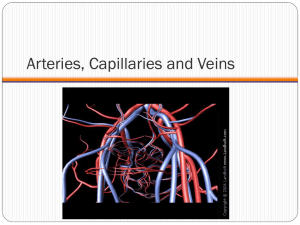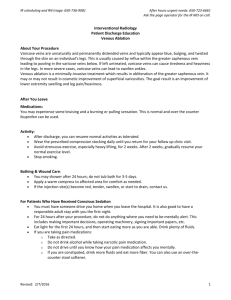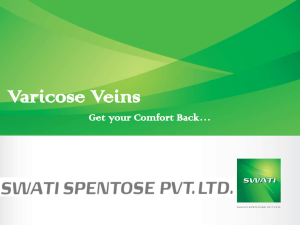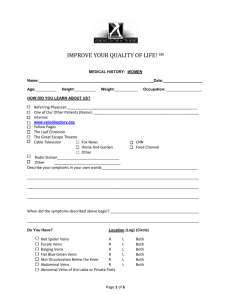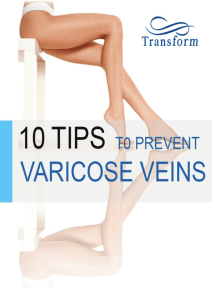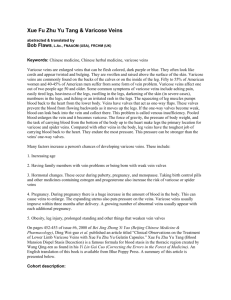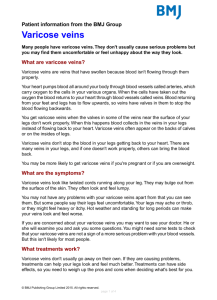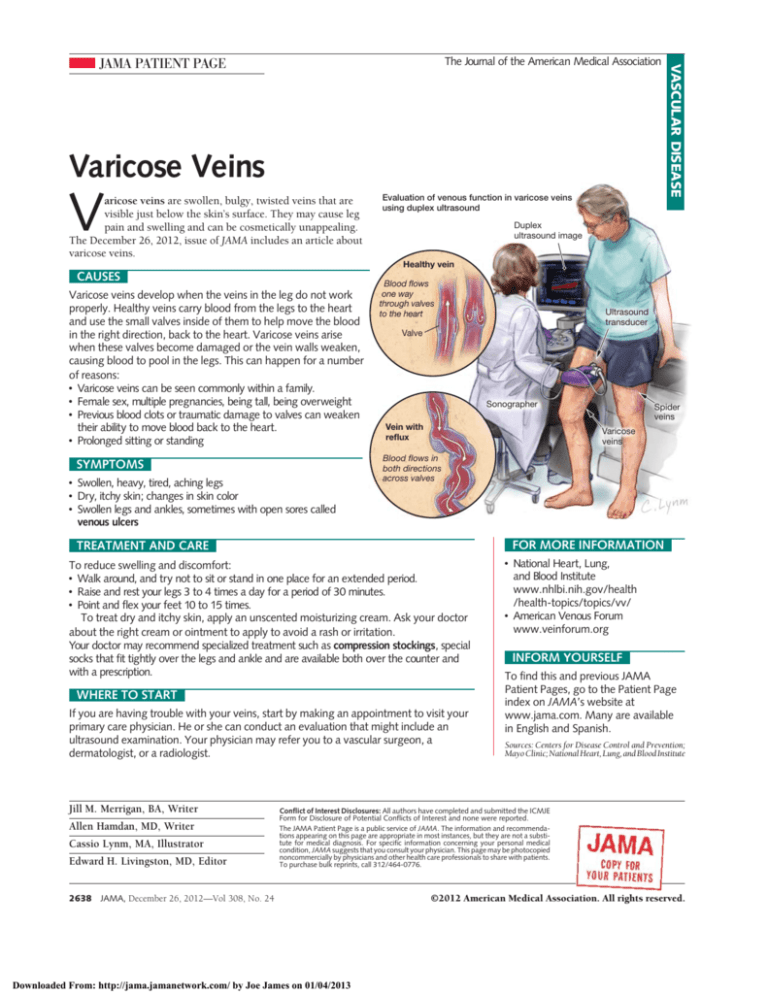
Varicose Veins
V
aricose veins are swollen, bulgy, twisted veins that are
visible just below the skin’s surface. They may cause leg
pain and swelling and can be cosmetically unappealing.
The December 26, 2012, issue of JAMA includes an article about
varicose veins.
Evaluation of venous function in varicose veins
using duplex ultrasound
VASCULAR DISEASE
The Journal of the American Medical Association
JAMA PATIENT PAGE
Duplex
ultrasound image
Healthy vein
CAUSES
Varicose veins develop when the veins in the leg do not work
properly. Healthy veins carry blood from the legs to the heart
and use the small valves inside of them to help move the blood
in the right direction, back to the heart. Varicose veins arise
when these valves become damaged or the vein walls weaken,
causing blood to pool in the legs. This can happen for a number
of reasons:
• Varicose veins can be seen commonly within a family.
• Female sex, multiple pregnancies, being tall, being overweight
• Previous blood clots or traumatic damage to valves can weaken
their ability to move blood back to the heart.
• Prolonged sitting or standing
SYMPTOMS
• Swollen, heavy, tired, aching legs
• Dry, itchy skin; changes in skin color
• Swollen legs and ankles, sometimes with open sores called
venous ulcers
Blood flows
one way
through valves
to the heart
Valve
Sonographer
Vein with
reflux
Blood flows in
both directions
across valves
FOR MORE INFORMATION
To reduce swelling and discomfort:
• Walk around, and try not to sit or stand in one place for an extended period.
• Raise and rest your legs 3 to 4 times a day for a period of 30 minutes.
• Point and flex your feet 10 to 15 times.
To treat dry and itchy skin, apply an unscented moisturizing cream. Ask your doctor
about the right cream or ointment to apply to avoid a rash or irritation.
Your doctor may recommend specialized treatment such as compression stockings, special
socks that fit tightly over the legs and ankle and are available both over the counter and
with a prescription.
WHERE TO START
If you are having trouble with your veins, start by making an appointment to visit your
primary care physician. He or she can conduct an evaluation that might include an
ultrasound examination. Your physician may refer you to a vascular surgeon, a
dermatologist, or a radiologist.
Allen Hamdan, MD, Writer
Cassio Lynm, MA, Illustrator
Edward H. Livingston, MD, Editor
2638
Spider
veins
Varicose
veins
TREATMENT AND CARE
Jill M. Merrigan, BA, Writer
Ultrasound
transducer
• National Heart, Lung,
and Blood Institute
www.nhlbi.nih.gov/health
/health-topics/topics/vv/
• American Venous Forum
www.veinforum.org
INFORM YOURSELF
To find this and previous JAMA
Patient Pages, go to the Patient Page
index on JAMA’s website at
www.jama.com. Many are available
in English and Spanish.
Sources: Centers for Disease Control and Prevention;
Mayo Clinic; National Heart, Lung, and Blood Institute
Conflict of Interest Disclosures: All authors have completed and submitted the ICMJE
Form for Disclosure of Potential Conflicts of Interest and none were reported.
The JAMA Patient Page is a public service of JAMA. The information and recommendations appearing on this page are appropriate in most instances, but they are not a substitute for medical diagnosis. For specific information concerning your personal medical
condition, JAMA suggests that you consult your physician. This page may be photocopied
noncommercially by physicians and other health care professionals to share with patients.
To purchase bulk reprints, call 312/464-0776.
JAMA, December 26, 2012—Vol 308, No. 24
Downloaded From: http://jama.jamanetwork.com/ by Joe James on 01/04/2013
©2012 American Medical Association. All rights reserved.




